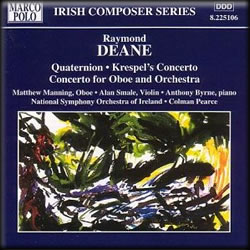
Audio
"Krespel’s Concerto" - National Symphony Orchestra

In 1983 RTÉ (Irish Radio and Television) commissioned "Krespel", a kind of radiophonic opera for speakers, vocal soloists, chorus and orcfhestra with a text taken primarily from Jules Barbier's libretto for Offenbach's "Les contes d'Hoffmann". In 1990 I recomposed the work for violin and large orchestra, subtitling it "Fatasia after E.T.A. Hoffmann". This version was given its première at Dublin's National Concert Hall in April 1997 with soloist Alan Smale, and the National Symphony Orchestra of Ireland conducted by Colman Pearce.
Hoffmann's "Rat Krespel" (1819) tells of the eponymous half-mad violin-maker, his prima donna wife Angela who dies of consumption, their daughter Antonia and her lover, the composer and pianist B... Krespel separates the lovers lest the composer induces her to sing, thus triggering the consumption that Krespel fears she may have inherited from her mother. A Cremona violin, played with magical intensity by Krespel, takes the place of her voice.
The first movement, Dramatis personae, portrays Krespel and Antonia in particular, the latter represented by a literal quotation of her aria "Elle a fui, la tourterelle" from Offenbach's opera. Indeed the whole work might be seen as a set of variations on this melody, the intertwining perfect fifths of which I associate with the open strings of the violin.
The second movement, Burial Scene, depicts Antonia's funeral and Krespel's outburst of grief-stricken madness.
The third movement, Carnivals, contrasts the frivolity of Venice and the vulgarity of Germany, combing the two in a collage through which Antonia's melody shines in the trumpet.
The fourth movement, Liebestod, evokes Krespel's mysterious vision of his daughter singing (alternately represented by solo violin and, again, trumpet) to the composer's accompaniment, both of them bathed in bright light. He bursts into her room and finds that she has died, in peace and alone. The work ends with a seemingly unambiguous closure rather atypical of my music, but appropriate in this context: "Krespel's Concerto", like its forerunner "Krespel", is a kaleidoscopic homage to 19th century romanticism - and to its death.